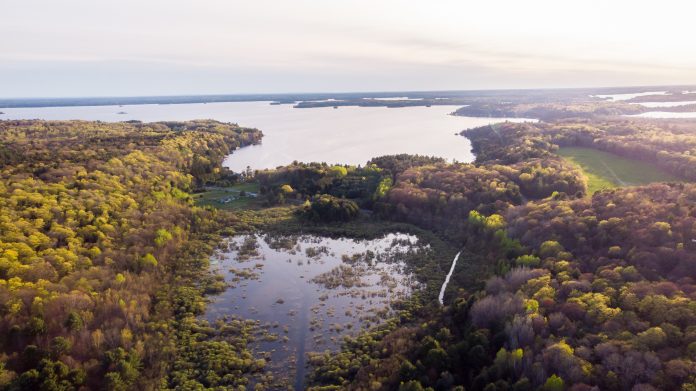
The second public meeting for a controversial proposed development in Bracebridge is coming up on Oct. 27, giving locals the chance to voice their opinions on the proposed private school known as Muskoka Royale College.
The upset surrounding the project spans back to early 2019 after Muskoka Royale Inc. submitted an application for official plan and zoning by-law amendments to allow for a private elementary school and secondary school as well as a sports complex and on-site residences for students and faculty; however, concerns surrounding the property span back even further. The property’s previous owners submitted plans for a resort and golf course back in 1991, but despite the approvals in place for the property, no development had occurred as of 2013 around the time the property came under new ownership. Plans for the site have shifted over the years, but the community’s concerns regarding the property have remained present for decades.
The current proposal
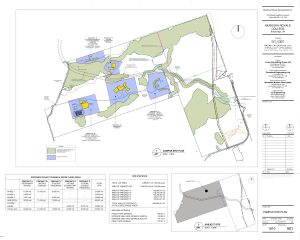
Toronto entrepreneur George Chen, the owner of the Muskoka Royale property, is seeking to build a five-precinct school complex on the land as his legacy project. The total parcel of land owned by Chen is 830 acres, but the proposed Muskoka Royale development only concerns the western portion of the property, a 443-acre plot of land east of Stephens Bay.
The eastern portion of Chen’s landholding includes multiple designations allowing for residential, commercial and other uses, and though Chen has no immediate plans for the land, “it is reasonable to expect that he will proceed with this development sometime in the future,” said Murray Snider, project coordinator for Muskoka Royale. Snider said he’s been involved in the project since its inception and he’s known Chen personally for over 10 years.
“George Chen was inspired to create this school largely because of his own children’s experiences attending Upper Canada College, Bishop Strachan, and most recently Cornell University,” Snider said. “These schools have created benefits for their communities for generations and Mr. Chen’s desire is to create a similar long-term beneficial relationship with Bracebridge. The approval process has been a lengthy one and it speaks to Mr. Chen’s commitment to its long term success.”
Chen envisions having up to 1,800 students at the school with a gradual build-up period of 15 to 20 years. The target percentage for international students is 33 per cent, according to town planning documents, and Muskoka Royale’s website states that most of the student body would come from the Greater Toronto Area with the remainder of students coming from elsewhere in Canada or the United States. During the summer months, the application proposes use of the facilities for summer camp.
The development is expected to provide the equivalent of 200 full-time construction jobs over a five-year period, according to Muskoka Royale’s website, as well as an estimated 200 to 250 full-time jobs once the school is complete, ranging from positions in teaching and administration to other roles such as maintenance and housekeeping. Chen has expressed a commitment to hiring locals both for construction and for long-term staff, and when he initially assembled the team for the project, Snider said he instructed them to source suppliers locally as much as possible. Snider himself is a local resident and their environmental consultant, education consultants and infrastructure engineer are local as well, he said.
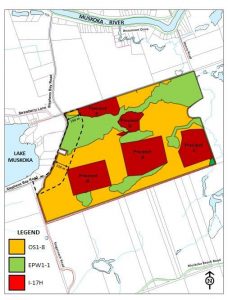
Snider also said that while the school will contribute to the local economy, their campus will include resources such as recreation facilities and a healthcare centre so that the school’s population won’t have to compete with the rest of the community for use of existing facilities.
“George Chen is confident that as the school grows and develops its reputation as a world-class educational institution it will increasingly serve as a strong community asset,” Snider said.
Richard Borland, president of the Bracebridge Chamber of Commerce, sent a letter in support of the project to council on behalf of the chamber’s board of directors in June 2019. Borland said they decided to voice their support because one of the chamber’s seven areas of focus is advocacy regarding important issues that impact the business community and the community at large. Given the size and scope of the project, Borland feels it would have a “significant positive spin-off effect” for the business community and the chamber as well as Bracebridge and Muskoka as a whole.
“Mr. Chen has indicated that he would be a generous community partner, including: the creation of a local bursary program; working with the Muskoka Conservancy on long term protection of the area; and improving the TransCanada Trail,” Borland said in the letter. “I don’t believe we have ever seen such a wide range of commitment from an investor with the same vision we have for our community and the willingness to help Bracebridge move forward and grow.”
Borland went on to say that with the loss of industry and the changing economy in the area, the board feels Bracebridge should not reduce its options when it comes to attracting families, businesses and entrepreneurs. He said that while there’s been some misinformation in the community, he has personally walked the property to understand the proposed campus layout.
“Swamps are not being drained, wetlands are not being destroyed, a future Hwy 118 bypass (should it actually occur in my lifetime) has nothing to do with this project,” Borland said in a written statement to Muskoka411. “Muskoka Royale College will end up being a beautiful campus that we will be proud to have in Bracebridge. It will drive traffic to our area and help to increase our population base, ideally providing more support to our Business Community during the winter months.”
Protecting wildlife and wetlands
Chen chose the site for school, which contains several wetlands and small watercourses as well as forested areas and rock barrens, because of its natural beauty, but the environmental features on the property have also been the source of scrutiny. In response to community concerns, Chen has repeatedly asserted his commitment to working with the Muskoka Conservancy on the long-term protection of Henry Marsh, a large portion of which is located on the Muskoka Royale property.

The conservancy is a land trust that works to monitor, maintain and protect 2,700 acres of land across Muskoka, including the Bert Cross Family Nature Reserve, which is adjacent to the Muskoka Royale site. Scott Young, executive director of the Muskoka Conservancy, said there has been a great deal of concern surrounding the protection of Henry Marsh since the land was designated urban in the town’s 1995 official plan.
The conservancy has a long history of working with community partners for the benefit of nature conservation, Young said, including businesses, environmental groups and even developers from time to time. When it comes to the Muskoka Royale property, Young said the conservancy has reached out on several occasions in an attempt to communicate with the different owners of the site.
“While we have received no direct communication from Mr. Chen, we have had conversations with the planning consultants that have been involved in the project,” Young said. “Muskoka Conservancy has made it clear all along that our top priority in this area is to protect Henry Marsh. It appears the planners agreed because Muskoka Royale proposed zoning protection for Henry Marsh and its related watercourses right off the bat.”
Young said that while the zoning protection is a good start, the conservancy has not received any formal commitment from Chen or his associates.
“We are cautiously optimistic regarding Mr. Chen’s statement that he is committed to working with our organization to further protect Henry Marsh,” he said. “We are open to the conversation. We look forward to learning what shape their commitment takes in the near future.”
The South Bracebridge Environmental Protection Group (SBEPG) formed in response to the Muskoka Royale proposal in spring 2019. The group’s director and president Michael Appleby said he co-founded the SBEPG after receiving comments on the development from over 70 per cent of the members in the Stephens Bay Association, for which Appleby was serving as secretary at the time.
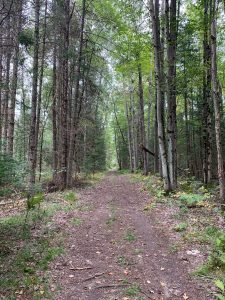
The group is concerned that, despite the proposed development footprint of only 15 per cent, the project and its eventual population density could harm the wetlands as well as the local wildlife in the area, which include species at risk such as Blanding’s turtles and least bitterns. In an effort to ensure informed public discussion, SBEPG sought out information from wetland experts, which soon led the group to retain their own environmental consultant to peer review the Environmental Impact Study (EIS) submitted by Muskoka Royale’s environmental consultant, Michalski Nielsen Associates Limited (MNAL).
SBEPG’s consultant raised a number of concerns about the EIS and recommended an evaluation of the site through the Ontario Wetlands Evaluation System (OWES). The town later initiated their own peer review of MNAL’s EIS, but a formal evaluation of the wetlands has yet to occur.
“Until the property has been properly evaluated, anybody trying to opine on this one way or the other really doesn’t know what is going on there,” Appleby said. “That said, environmental scientists or wetland scientists that are familiar with the property are pretty much convinced that it would be provincially significant.”
MNAL rejected calls for a wetlands evaluation in a letter to the town earlier this year, stating “there is no reason, nor any precedent” for the evaluation. If the wetlands were deemed provincially significant, MNAL said it would have “absolutely no impacts on the present development proposal,” adding that the plans include “robust” buffers around all wetlands “save for small sections of a roadway alignment that has already been approved by the province.”
Snider said the buffers are consistent with those being established around sensitive wetlands across Ontario, including provincially significant wetlands. Aside from Henry Marsh, the wetlands on the property will be buffered by a minimum of 15 metres with an average buffer of at least 30 metres, according to MNAL.
“We’ve committed to providing at least an average minimum buffer of 30 metres adjacent to all wetlands on the property,” Snider said. “Henry Marsh, the largest and most ecologically diverse wetland on the property, will have a minimum buffer of 30 metres and in fact, no development is intended within 250 metres of this wetland.”
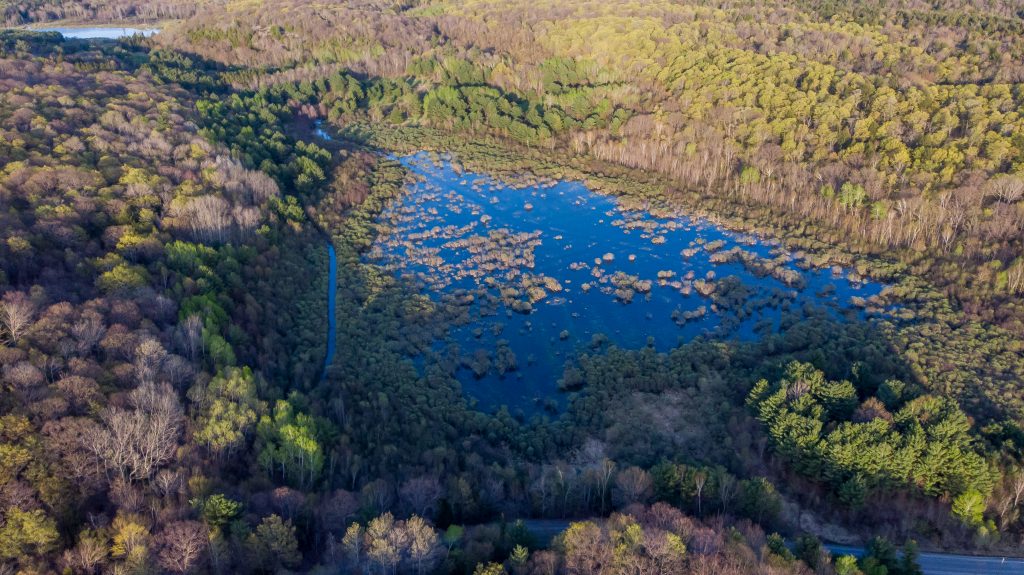
Sarah Finkelstein, a geoscientist with training in ecology, geography and the earth sciences as well as an associate editor for the academic journal Wetlands, said she encourages the municipality to initiate an evaluation through OWES because it will clarify important details about the wetlands, including what their boundaries are and other information to determine the appropriate size of the buffer areas.
“If you don’t know what the soil carbon stocks are, for example, if you don’t know what the vegetation consists of and what habitat it’s providing, it’s really hard to make a recommendation about the buffer,” Finkelstein said. “Just applying 30 metres or 100 metres doesn’t really make a lot of sense to do until you have the evaluation data.”
Finkelstein is an associate professor in Earth Sciences at the University of Toronto, and one of her primary research interests is wetlands and their ability to mitigate climate change. Along with providing haven to many species that are already struggling due to extensive habitat loss, wetlands play an important role in flood mitigation in addition to collecting and storing carbon.
“It’s not only that we just lose habitat if we destroy the wetlands, it’s that we’re actually making the climate crisis worse because we’re taking all that carbon in the soil and we’re putting it in the atmosphere,” Finkelstein said. “If we conserve our wetlands, those wetlands will continue helping us by locking away carbon in the soil in a really powerful way compared to other ecosystems.”
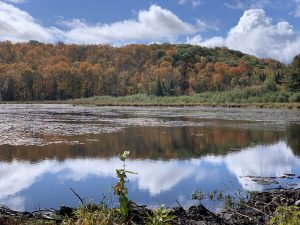
Finkelstein has worked in partnership with government scientists and organizations such as the Nature Conservancy to contribute to evidence-based policy decision-making, and throughout her work, she’s seen time and time again how land-use decisions play a crucial role in preserving wetlands.
“What we’ve learned from looking at this catastrophic loss of wetlands that we’ve experienced in Ontario over the last 150 years is that even if you make changes that are far away from the wetland, like hundreds of metres or more, it’ll still impact the hydrology of the wetland and the ability of that wetland to take up carbon stored there and to provide habitats,” Finkelstein said. “I know you often hear the word sensitive for different ecosystems, and every ecosystem is sort of sensitive in its own way, but wetlands really are sensitive to hydrological change.”
While she hasn’t studied the site, Finkelstein said based on what is known about wetland losses in Ontario, the wetlands are probably smaller than they once were and many of the neighbouring wetlands that would have been present across Muskoka have already been lost. She recognizes that these developments include many stakeholders and can be important for the region, but she encourages council to do whatever possible to protect the fragile ecosystems contained on the property.
“It’s tough for the decision makers, but I do think what the science says is that wetlands have unique properties, and they kind of pull above their weight in terms of providing habitat and presenting the opportunity for natural climate solutions,” she said. “My recommendation would be to try to maintain the ecosystem function of that wetland as much as possible and to do that would require the largest possible buffer.”
Determining next steps
Bracebridge Mayor Graydon Smith said town council has received numerous emails about the project over the last 18 months, many of which have called for a formal evaluation of the property through the OWES. There’s no lack of understanding within town council when it comes to the importance of wetlands, he said, but he wants locals to understand that council isn’t going to act based only on a group of emails.
“We need to receive a report back from our staff, and within those reports are analyses of the current information on hand,” Smith said, adding that those reports will help determine whether the evaluation is necessary or if the current information they have properly addresses the concerns surrounding wetlands. “We haven’t had a meeting about this project, so when we do, we’ll make a decision on that. Either somebody will bring a motion forward, or maybe there’s a recommendation from staff, we’ll have to see what staff bring back to us.”
Smith said while it’s always great to have the public involved, he’s concerned that some people may be participating purely due to a public relations campaign launched by a local group known as Protect Muskoka. The group has been circulating a petition in opposition to the project, citing concerns about the project’s potential impact on the environment, local infrastructure and more. Smith said he’s troubled by the group’s lack of transparency as well as the lack of evidence provided for the content on their website.
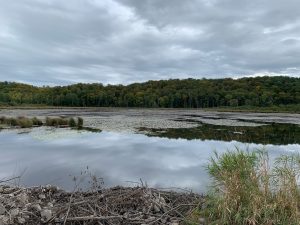
Protect Muskoka has encouraged people to send council their thoughts on the proposal, and many have done so without providing essential details, Smith said, so he doesn’t know whether they’re local or if they simply saw a social media campaign. He encourages those interested in commenting on the development to provide their full names and addresses or, at the very least, an explanation of who they are and their connection to the application. Smith also emphasized that during this process, council is considering the application from a planning perspective and examining issues related to land use, not evaluating other aspects of the proposed project.
“Planning isn’t about who the developer is, land-use planning isn’t about the business plan,” Smith said. “A lot of people have talked about, ‘Why here and why this person?’ Because somebody bought the land, and they put an application in. That’s why we’re evaluating it.”
Smith said that it’s a process-driven, data-driven scenario where public input is important, but at the end of the day, council’s decisions need to be justifiable should they be appealed to the Local Planning Appeal Tribunal (LPAT) in the future. The second public meeting on Oct. 27, which is set to happen virtually through Zoom at 2 p.m., will play an important role in determining what’s next for the application.
“We’re obviously going to receive a lot of comments, and we want to give those comments the respect they deserve and make sure that staff have some time to think about those and evaluate those as council needs to as well,” Smith said. “That will inform the next step in the process.”
Smith is unsure when the issue will come back to council for a vote, but the town is aiming to move things along as quickly as possible given the already lengthy application process. Their goal as the agency in the middle is to make a decision while respecting parties on both sides as much as they can, Smith said. He wants to assure locals that no final decisions have been made regarding the application and asks the public to trust in the process.
“It’s been implied a number of times in things that I’ve either read on social media or in some conversations I’ve had that council has already made up its mind, and that’s not the case,” Smith said. “Council doesn’t make up its mind until it takes a vote, and so we’re not going through the process as window dressing. We’re going through this process because this is the way business gets done, and we’ll give everybody a fair opportunity to be heard and evaluate everything accordingly.”
For more information on the public meeting and how to participate on Oct. 27, click here.







